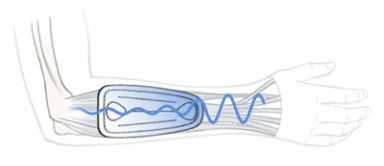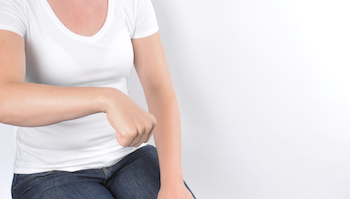Tennis Arm or Tennis Elbow
An overview of the origins, most common causes, symptoms and medical treatment of tennis arm/tennis elbow.
What is Tennis Arm?
Tennis Arm (lateral/radial epicondylitis), also known as tennis elbow, is the inflammation of the exterior of the elbow, or more specifically the exterior of the lateral epicondyle: the protrusion at the end of the main bone in the forearm (the humerus bone) to which the base of the tendons and muscles in the forearm are attached. If the extensor muscle (the muscle responsible for the bending and straightening of limbs and digits, the forearm in this case) is compressed or put under tension, inflammation of the tendon occurs in the muscle origin (the base of the muscle which connects directly to the bone). In tennis arm, the tendon origins (the base of the tendons) in the hand and fingers are also affected.
The condition arises especially in cases where one arm is under excessive load, as in ball sports such as tennis, for example, where the name of the condition originates. However, it is not only athletes who are affected by tennis arm. Artisans and musicians also often carry out repetitive tasks and are therefore at risk. Office workers can also be affected, leading to the term "mouse arm."
Tennis elbow must not be confused with golfer’s elbow. If you are suffering from golfer’s elbow, the pain is located on the inside of the elbow while the outside of the elbow is affected in the case of tennis elbow.

Common Causes
If the muscles in the forearm are put under too much load or undue stress, this leads to inflammation of the tendon, which is responsible for stretching the muscles. There is therefore intense continuous or undue strain in these muscles. Another cause of tennis arm can be instability in the outer ligaments, which may be caused by accidental injury.
If the outer ligaments of the elbow are unstable, the extensor muscles in the forearm must offset this instability during movement. This leads to excessive load on the muscles and therefore to inflammation of the tendon. Further causes may be, for example:
- Sports such as table tennis, badminton, rowing, tennis, etc.
- Repeated manual labour.
- Playing a musical instrument, such as violin, drums, or piano.
- Working with a computer mouse and keyboard.
- Working as a cashier in a supermarket.

Typical Symptoms
Even light external pressure can cause pain in the elbow if you are suffering from tennis arm. This pain can also partially extend to the upper arm and forearm. The pain is stronger when there is movement of the arm, as the extensor muscles are in use during movement.
Furthermore, inflammation of the tendon also affects the function of the hands and fingers. As muscle movement is weakened, the patient feels a clear loss of strength in the hand. Lifting objects, overstretching the hand, or simply gripping an item can cause pain.

Differential diagnosis of elbow pain
Apart from tennis or golfer’s elbow, pain in the elbow can be triggered by a number of other conditions. Any existing pain should be ruled out as an alternative cause by a physician before the tennis elbow diagnosis is made. Other possible differential diagnoses might be:
- Bursitis: inflammation of the bursa sacs
- Degeneration of the joints: arthrosis
- Impingement: blockage in the joint (due to a fall, for example)
- Pinched nerve in the cervical spine
Conservative Treatment and Therapy
Treating tennis arm requires patience above all else. First and foremost, the arm must be rested and excessive or undue strain must be avoided. Applying a cold compress or salve containing Diclofenac (an NSAID) will provide initial pain relief. In addition, physiotherapy from a physiotherapist experienced in manual therapy is recommended. It will also be helpful to learn strengthening exercises that are specific to the wrist and forearm, as these will counteract the pain in the long term.
Other treatment options, whose effectiveness have still not been fully researched, are for example: ultrasound therapy, laser treatment, electric stimulation therapy, acupuncture, and botox, to name but a few.
Specially developed orthopedic supports and orthoses can support the healing of the elbow. They relieve the burden on the muscle origins while also allowing room for movement to counteract muscle degradation. Then, with gentle pressure on the muscles, the tissue is better supplied with blood and any possible swelling subsides.
‘What works against tennis elbow’ at a glance
● Physiotherapy
● Bandages
● Cryotherapy (cold therapy)
● Acupuncture
● Laser therapy
● Kinesio Taping
● Epicondylitis clasp
● Injection of botulinum toxin into the tendon insertion
● Anti-inflammatory medication
● Current therapy (electrotherapy)
● Shockwave therapy (ESWT)
● Ultrasound
How does a bandage help against tennis elbow?
While you should go easy on your arm and avoid physical strain on it once you have been diagnosed with tennis elbow, you should not completely immobilise it. Quite the opposite: the patient should maintain active arm movements in order to keep it mobile and prevent muscle loss.
Most aids, such as bandages or clasps, take the strain off the elbow by changing the tensile direction of the tendon. Epicondylitis clasps apply targeted pressure to the tendon insertions which takes the strain off the epicondyle. The correct fit of the clasp is crucial: it should sit on the muscle belly, just in front of the area of pain (not on it).
The Dynamics Plus Epicondylitis Support on the other hand, functions differently to typical bandages or clasps. It has a large, flat pad which sits on the forearm and acts as shock-absorbing cushioning. This clasp absorbs muscle vibrations caused by hand movements and thereby softens the stimuli transmission to the elbow.
Regardless of which type of bandage you eventually choose, wearing a clasp or bandage can support the treatment of tennis elbow significantly and promote a fast healing process.

Surgery
In some rare cases, the above treatment options are not sufficient and surgery must take place. This only occurs, however, if the condition has existed for more than six months and conservative treatments have been shown to have no effect. Surgery will also take place in the event that the muscle or tendon is torn.
Damaged sections of the tendon and inflamed tendon tissue will be removed during surgery and the will be reset. In order to prevent pain transmission, targeted nerve pathways can also be severed in isolated cases. Three months after surgery, the elbow can be put under strong load again. It is recommended that, depending on the method of operating, the elbow should be kept still for around two weeks prior to surgery; if necessary, a plaster cast can be used. Afterwards, little by little, the joints can then be put under light strain.
Length of sick leave when suffering from tennis elbow
If you are suffering from pain in your elbow, you should consult a doctor as soon as possible to confirm a diagnosis. Do not wait for too long as you might otherwise risk chronic inflammation. If the diagnosis is indeed tennis elbow, it is important to reduce any physical strain on the elbow. As the healing process differs from one person to another, a specific time period for the recovery, and hence the sick leave, cannot be pinpointed.
It can take months for chronic tennis elbow to heal up completely. Depending on how far the inflammation has progressed, the length of the sick leave can vary considerably. It also depends on the patient’s type of job and whether it can make the symptoms worse.
Prevention
Stretching before, during and after physical strain helps to protect your muscles from tension and to prevent tennis elbow.

In order to prevent tennis elbow, you can do the following exercise several times a day for 2 minutes. If you’re suffering acute symptoms, please consult a physician or physiotherapist before beginning this training.

Step 1: Make a fist and flex the wrist.
Step 2: Slowly extend the arm.
Step 3: At the same time, use your other hand to gently push the wrist backwards.
Step 4: Hold this position for two minutes.
Step 5: Repeat the same exercise with the other arm.

If you are suffering from acute symptoms, you can repeat the exercise every hour and in a gentle rhythm until you do not experience pain anymore while doing the exercise – however, please speak to your physician first before starting this exercise.




